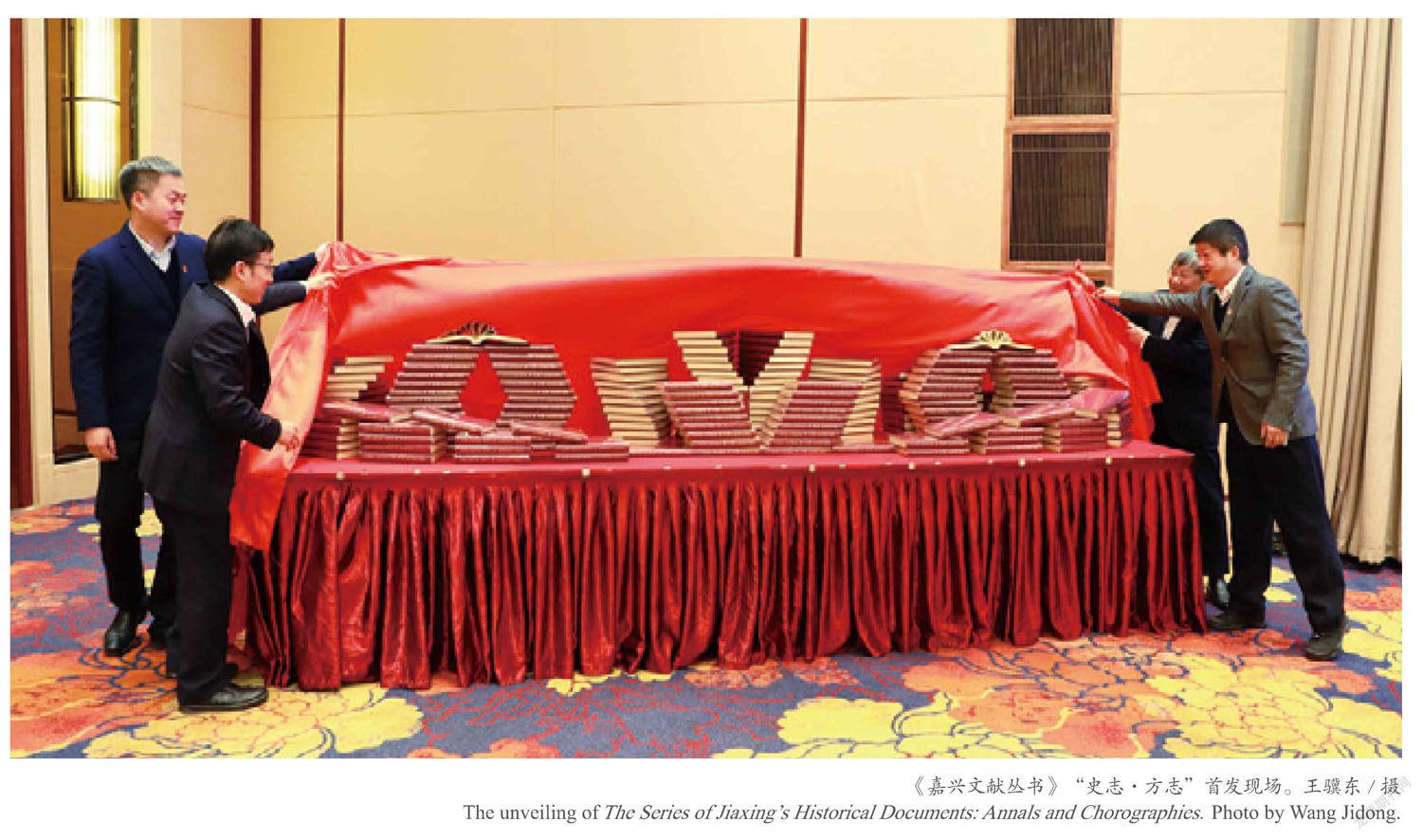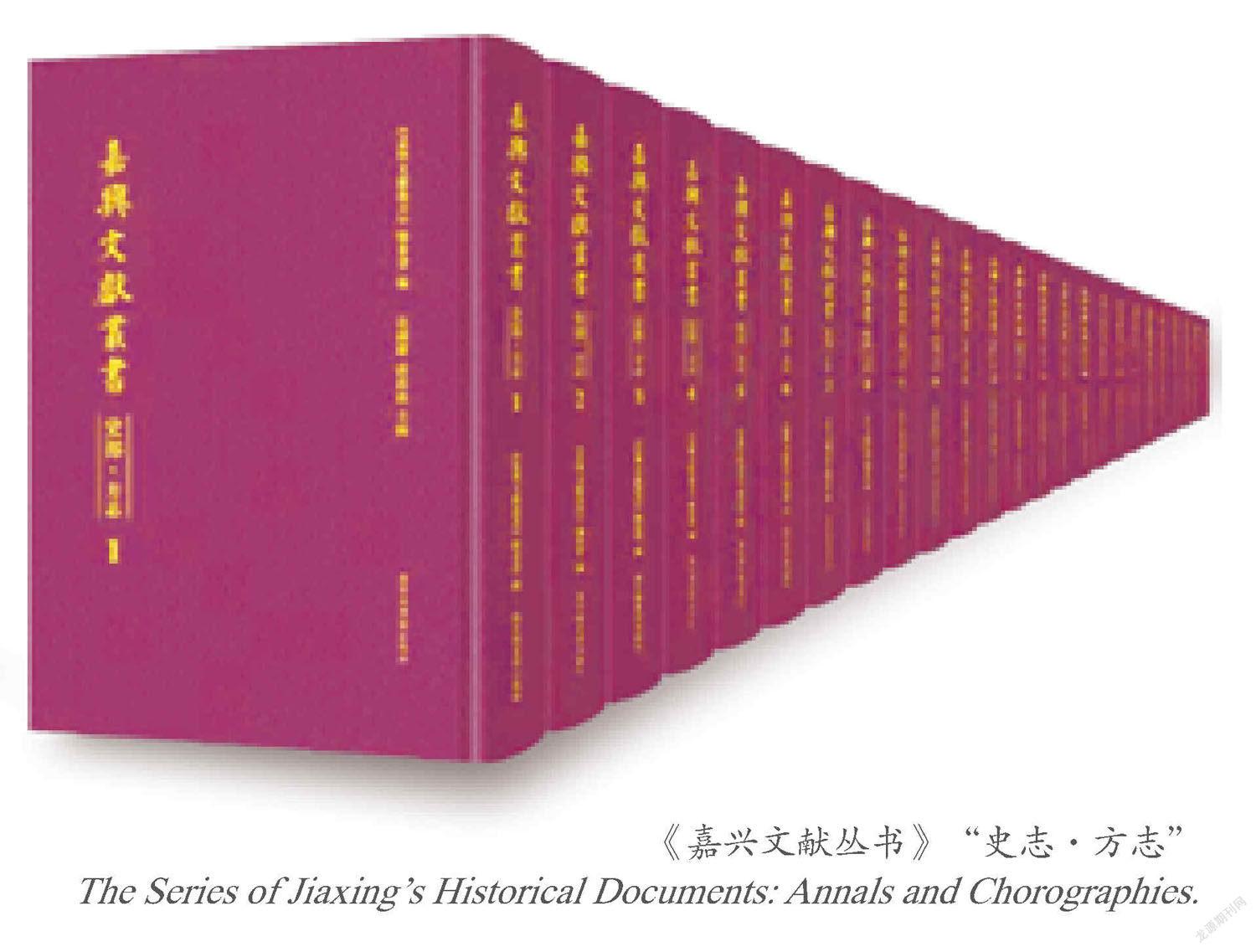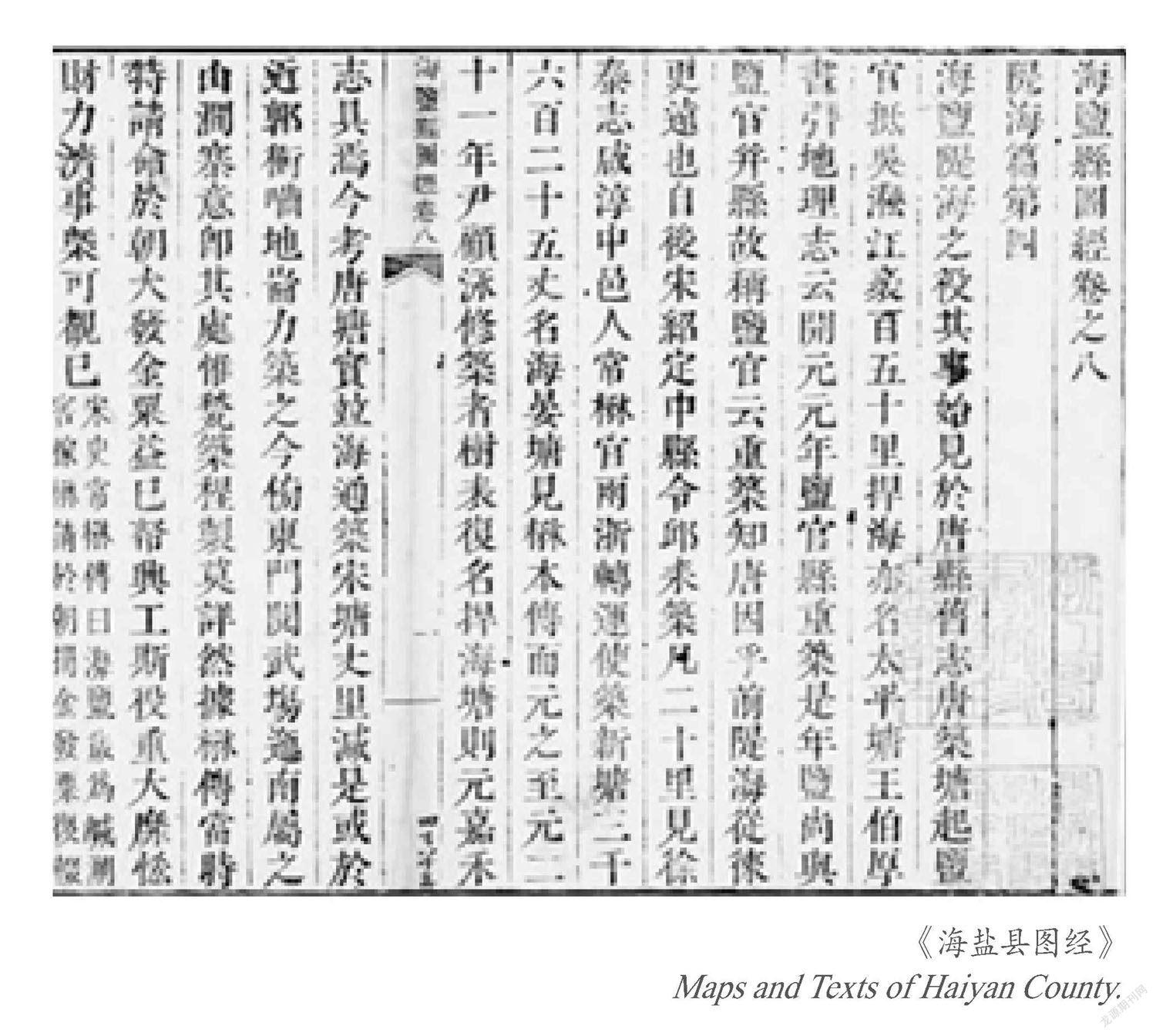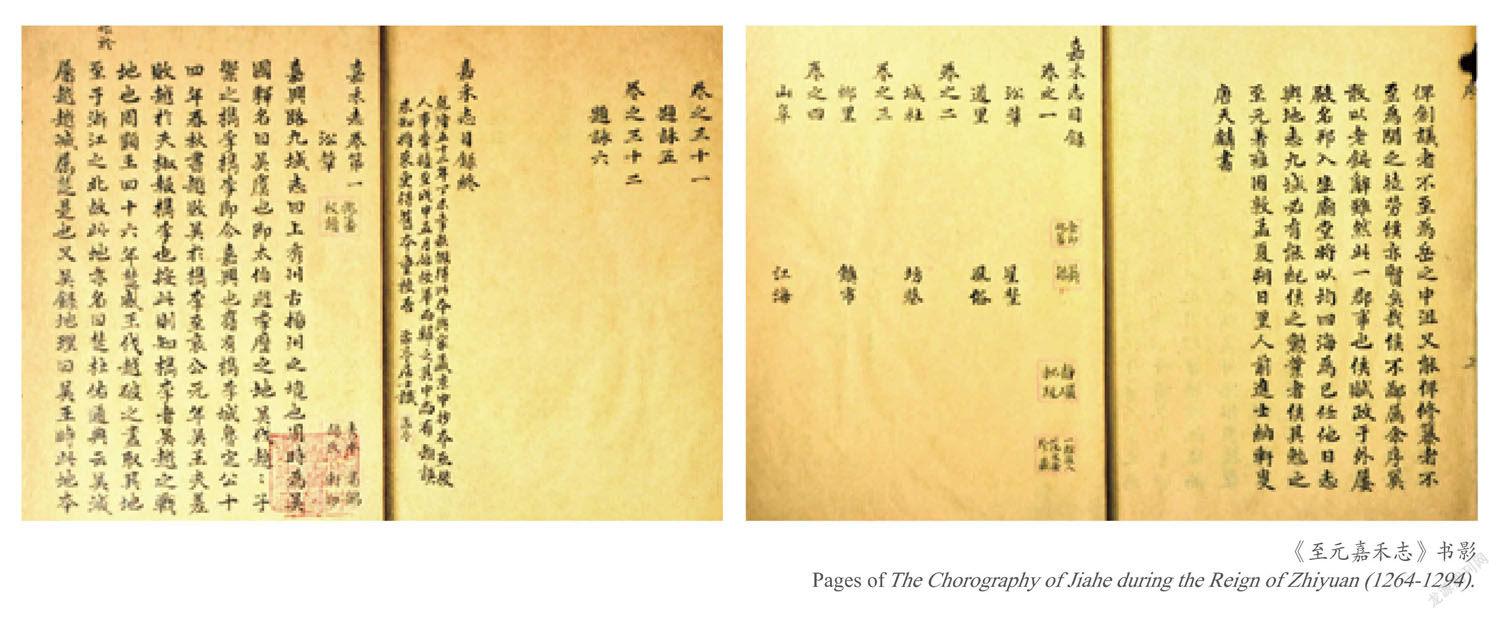文献丛书的“嘉兴样本”
陈苏 周伟达 刘博见





中国现存最早的乡镇志《澉水志》是何人所编?现存最早的嘉兴府志《至元嘉禾志》记录着怎样的历史往事?
1月16日上午,《嘉兴文献丛书》“史部 · 方志”首发。
“史部 · 方志”共百册,基本囊括嘉兴现行行政区域内的所有地方志,共114种,是嘉兴有史以来第一次全面系统的对嘉兴地方志文献的搜集与总汇。
《嘉兴文献丛书》是嘉兴迄今规模最大、学术体系最完备、文化元素最齐全的大型地方文献总集,“史部 · 方志”是其重大阶段性成果。
客观展现嘉兴历史文献原貌
嘉兴有7000年人类文明史、2500年文字记载史和近1800年建城史,悠久的历史孕育出灿若星河、风华绝代的名家大师,也沉淀下浩如烟海、珍贵无比的历史文献典籍。
嘉兴历史上的各类典籍大多保存完好,却分散收藏于各地,有的已成孤本,有的至今未曾刊印,仅有稿本、抄本传世,查阅不便。《嘉兴文献丛书》主编、复旦大学教授葛剑雄在《嘉兴文献丛书》序文中说 :“《嘉兴文献丛书》的汇编出版,不仅能使这些文献典籍得到延续,而且为嘉兴的文化建设、学术传承、社会发展提供完整的历史数据和丰富的精神源泉,洵为盛世中的盛事。”
2019年,嘉兴学院联合嘉兴市图书馆、嘉兴市社科院文化研究所、浙江大学古籍研究所、南京大学人文学院和国家图书馆出版社等单位,启动嘉兴文脉整理研究工程,计划用5年左右时间,编纂出版《嘉兴文献总目》3卷和《嘉兴文献丛书》300册、《嘉兴文献丛书 · 提要》3册。《嘉兴文献丛书》主编卢新波希望借此梳理嘉兴历史文脉、保存嘉兴集体记忆、梳理嘉兴地方历史、建设嘉兴文化高地。
“史部 · 方志”是《嘉兴文献丛书》的阶段性重要成果。据即将出版的《嘉兴文献总目》统计,仅史部,历代嘉兴人著述2600余种,此次丛书选入359种,其中嘉兴历代方志占比近三分之一,因数量庞大,所以单列“史部 · 方志”。
中国传统方志修纂始于宋,基于明,盛于清,延于民国。就全国目前8000余部的存量方志看,江浙地区最多,嘉兴方志无论在数量还是质量上都可圈可点。《嘉兴文献丛书》“史部 · 方志”百册,本着“应收尽收”的原则,不仅对民国以前嘉兴各种地方志,基本做到资料翔实、搜罗无遗,在范围上覆盖府、县、镇三级行政区划(共有114种,数量可观),而且全书以影印刊行,再现历史文献原貌,完整保存文献价值与版本价值,客观呈现其历史文献的真实性与原始性。
基本摸清嘉兴文献家底
不少方志在传抄、递修过程中,出现多个版本,丛书编纂团队对此作了反复甄别、比较,挑选出价值最高的版本。如《嘉靖海宁县志九卷》,在《中国古籍善本书目》著录的是清抄本,而此次采用的是明嘉靖三十六年(1557)的初刻本。
尤其值得一提的是,现存嘉兴最早的府志《至元嘉禾志》,编纂团队发现了12个版本,此次选用的是倪禹功精抄本。
这不仅着眼的是其文献价值,更是彰显嘉兴先贤保存文献之功。
20世纪50年代初,嘉兴图书馆时任馆长汪大铁有心收齐现存嘉興地区的所有志书。受其委托,嘉兴乡贤倪禹功在上海代为走访。《至元嘉禾志》存世多为抄本,汪大铁打听到旅居上海的嘉兴人金篯孙曾藏有该志抄本,倪禹功在30年代与其多有来往。彼时,金篯孙已过世,倪禹功找到其子金问源,主动承担为嘉兴无偿抄录《至元嘉禾志》的任务。倪禹功整整花了五个月才抄完此书。
《至元嘉禾志》倪禹功抄本的这段往事,正是嘉兴先贤保护乡邦文献的一则美谈。
而今,《嘉兴文献丛书》汇聚嘉兴及国内学术界、文化界众多知名专家学者,形成由学养深厚的文史专家主持、全国多所高校专家学者参与、地方文化专家和出版社研究人员协同的编纂委员会,对嘉兴地方文献进行分类、梳理、校勘。
编纂委员会用近两年的时间基本完成了嘉兴古籍的全面普查登记,其中,嘉兴市图书馆普查古籍8392部,五县(市)图书馆近万部;同时,委托浙江大学古籍研究所方建新教授团队完成《嘉兴古代著述目录》研究项目,同步编纂《嘉兴文献总目》,统计近万种文献,基本摸清嘉兴文献家底。
汇成嘉兴地方志“族群”
嘉兴存世最早的府志是元至元二十五年(1288)刊行的《嘉禾志》,这便是后世所称《至元嘉禾志》,钱大昕、黄丕烈等人都曾批校此书。葛剑雄在序文中专门提到此书,“国内外现存宋元方志不足百种,其中便有《至元嘉禾志》三十二卷。”
嘉兴府志,创于宋,成于元。据《四库全书总目提要》所载,早在南宋淳熙年间,知州张元成请闻人伯纪修府志,后来岳珂担任嘉兴知府时,请关栻续修,岳珂改调,中辍,仅存五卷。直到元至元年间,单庆修,徐硕纂辑,才完成此书,“叙次甚详,每条下间系以考证,尤为典核”。
此书三十二卷,分四十三门,篇目既设“城社”,又立“坊巷”,既设“乡里”,又设“镇市”。又因嘉兴水网密布,详细搜罗嘉兴水网源流,阐明嘉兴自然地理、水文状况及其与农业、交通运输的关系,使得后世很容易“借志以考地理”。尤其是“碑碣”部分,保存了大量南宋以前的石刻文,这对了解南宋以前的嘉兴历史有着重要意义。
《至元嘉禾志》为嘉兴历代修志奠定了以文献为根基、文化为底色的基本特点。此后,明弘治、正德、嘉靖、万历,清康熙、嘉庆、道光、光绪等朝纂修嘉兴府志,递相沿革,代代接力,最终形成蔚为大观的嘉兴地方志“族群”。
“嘉兴样本”成地方志宝库
嘉兴地方志有其鲜明的“地方性”。从时间维度而言,宋元以来,代有志书修纂,从空间维度而言,府有府志,县有县志,甚至村镇皆有志。在历史的时空里,嘉兴方志构建出一个立体网状结构,共同搭建起一个既可宏观看待江南地区,又能微观梳理江南社会肌理的地方文献系统。嘉兴的地方志系统,堪称中国地方志宝库的“嘉兴样本”。
《澉水志》是其中具有里程碑意义的志书,是我国历史上现存最早的镇志。宋绍定三年(1230),罗叔韶任海盐县澉浦镇监,在他的支持下,常棠开始编纂《澉水志》,耗时二十余年,直到宝祐四年(1256)才刊印成书。全书共8卷,分地理、山、水、廨舍、坊巷、坊场、军寨、亭堂、桥梁、学校、寺庙、古迹、物产、碑记、诗咏15门,并附地图以及罗叔韶与常棠二人序言。《四库全书总目提要》称其“体例精严、藻不妄抒”。
“一個地方的学术文化成果能否最大程度地保存至今,还有赖于前人的收罗汇集、出版传播,尤其是本地先贤持续不懈的努力。所幸嘉兴代有贤人,传统不绝。”中国留下来的8000多部方志中,葛剑雄认为嘉兴拥有的地方志无论数量还是质量都是首屈一指的。在嘉兴,不仅仅县一级的地方志保存相当完整,还流传下来很多当地先辈自发组织修纂的乡(镇)、村一级地方志,这些资料充分体现了嘉兴在历史上的重要地位,证明嘉兴的先人在各方面为中华文明作出的杰出贡献。首发式上,葛剑雄为嘉兴人点赞,“嘉兴拥有丰富的资源,又能够在今天进行全面的调查、整理、修纂、出版,证明了今天的嘉兴将继续在继承和弘扬中国优秀传统文化中作出重要贡献。”
不少专家和学者认为,《嘉兴文献丛书》的出版对发掘和梳理嘉兴历史文脉意义重大,不仅填补了嘉兴古籍文献集成出版的空白,彰显嘉兴对中华文化发展的历史贡献,而且为打造新时代文化高地的典范城市存储了人文资源,更为推动嘉兴经济发展、社会进步提供了强大的精神动力和文化支撑。
A Prime Example of Chorographies in China
By Chen Su Zhou Weida Liu Bojian
Who compiled The Chorography of Ganshui (Ganpu township in Jiaxing, Zhejiang province), and what events and stories were recorded in The Chorography of Jiahe during the Reign of Zhiyuan (1264-1294) (hereinafter The Chorography of Jiahe), the earliest existing chorographies of towns and the prefecture-level cities respectively? On January 16, 2022, The Series of Jiaxing’s Historical Documents: Annals and Chorographies (hereinafter Annals and Chorographies) made its debut.
Consisting of 100 titles in 114 volumes, the Annals and Chorographies covers the chorographies of almost all the places currently within the administrative area of Jiaxing. It is the first time that chorographies have been ever collected and compiled in the history of the city.
With a history of 7,000 years of human civilization, 2,500 years of written record and nearly 1,800 years of city construction, Jiaxing has been home to great masters and precious historical literature.
Jiaxing’s ancient books and documents have been mostly well-preserved, but they have been scattered in different places in the area. Some are now the only existing copies, and some have been never printed, with only the original or handwritten copies left, thus inconvenient for people to access. Professor Ge Jianxiong from Fudan University, editor of the Annals and Chorographies, said in its prologue, “The compilation and publication will help the dissemination of these ancient books and classics and serve as the historical evidence and spiritual source for cultural, academic and social development of Jiaxing city.”
In 2019, Jiaxing University launched a project, working with Jiaxing Library, Cultural Institute of Jiaxing Academy of Social Sciences, Institute of Ancient Books of Zhejiang University, School of Liberal Arts of Nanjing University and National Library of China Publishing House, to compile and publish three volumes of The General Catalog of Jiaxing’s Historical Documents, 300 volumes of The Series of Jiaxing’s Historical Documents, and three volumes of Synopsis of the Series of Jiaxing’s Historical Documents. Lu Xinbo, a professor from Jiaxing University and editor-in-chief of The Series, hopes that the efforts will sort out historical progress, preserve collective memory and highlight the local history to make Jiaxing culturally significant.
The publishing of the 100 titles of the Annals and Chorographies is a milestone of The Series. According to the upcoming The General Catalog of Jiaxing’s Historical Documents, there are more than 2,600 kinds of historical records by generations of Jiaxing people, among which 359 kinds are selected in The Series. The local chorographies account for about one third among these, so the Annals and Chorographies has been singled out for publications.
The practice of compiling and revising local chorographies in China started from the Song dynasty (960-1279), matured in the Ming dynasty (1368-1644), flourished in the Qing dynasty (1616-1911) and continued to grow in the Republican period. Among the 8,000 local chorographies across China, Jiangsu and Zhejiang provinces enjoy the biggest proportion and Jiaxing has a prominent position both in quantity and quality. The 100 titles in 114 volumes have included almost all the local chorographies of Jiaxing before the Republican period, covering such administrative regions as cities, counties and townships. Photocopies of The Series are provided, both retaining its historic and edition values and presenting its authenticity and originality.
Due to the different editions of many chorographies during the process of their copying and revision, the compiling team made efforts to identify and select those with the highest value. For example, the first block-print edition (in the year of 1557) of The Chorography of Haining County During the Reign of Emperor Jiajing (1522-1566) were chosen instead of the transcripts in the Qing dynasty from the Bibliotheca of China’s Ancient Books.
One thing worth mentioning is that altogether 12 editions of The Chorography of Jiahe during the Reign of Zhiyuan (1264-1294), the earliest extant chorography on Jiaxing, have been discovered, and among them, the meticulous handwriting copy by Ni Yugong (1911-1964), a scholar in Jiaxing, is selected.
In the early 1950s, Wang Datie, then head of Jiaxing Library, was devoted to collecting existing chorographies of the city and commissioned Ni Yugong to explore Shanghai for such a mission. Most of the existing editions of The Chorography of Jiahe were its copies, one of which was owned by Jin Jiansun from Jiaxing living in Shanghai. Ni tried to get in touch with Jin in the 1930s, but unfortunately the latter had passed away before he reached him. Then he had to turn to Jin Wenyuan, Mr. Jin’s son, and volunteered to copy the book for free, which eventually took him five months to complete.
The story is a vivid example of those scholars and intellectuals in their endeavor to preserve the local chorographies.
The Series was made possible, thanks to the compilation committee of academicians both in Jiaxing and across the country, made up by experts from the intellectual circles and institutions of higher learning, as well as research staff from publishing houses.
It has taken the committee two years to examine the ancient documents and records on Jiaxing and have them registered. Jiaxing Library accessed 8,392 books, and libraries at Jiaxing’s three county-level cities and two counties have checked about 10,000 books. At the same time, the team led by Professor Fang Jianxin from the Institute of Ancient Books of Zhejiang University has been entrusted with the project of The Catalog of Ancient Books of Jiaxing and of compiling The General Catalog of Jiaxing’s Historical Documents. By doing so, a broad picture of ancient records on Jiaxing has taken shape.
The earliest existing chorographies of Jiaxing city are The Chorography of Jiahe (published in the year of 1288 during the Yuan dynasty), later popularly known as The Chorography of Jiahe during the Reign of Zhiyuan (1264-1294). According to Ge Jianxiong, of the no more than 100 extant titles of chorographies dated to the Song and Yuan dynasties, The Chorography of Jiahe accounts for 32 volumes.
The compiling of chorographies of Jiaxing as a prefecture-level city started in the Song dynasty and thrived in the Yuan dynasty. According to The Catalog of the Complete Collection of the Four Treasures, during the reign of Chunxi (1174-1189) in the Southern Song dynasty (1127-1279), a provincial official by the name of Zhang Yuancheng asked Wenren Jixiu to compile The Chorographies of Jiaxing and later Zhang’s successor Yue Ke commissioned Guan Shi to continue the job, but he did not finish, with only five volumes left. It was not until the Zhiyuan period in the Yuan dynasty that the entire project was completed.
Made up of 32 volumes and 43 categories, The Chorography of Jiahe includes such section as “cities”, “streets”, “villages” and “towns”. It shows Jiaxing’s geography, hydrology, and their relationships with agriculture and transportation, so that later generations can have a better understanding of its geographical conditions. The “stone tablet” part preserves a large number of stone inscriptions before the Southern Song dynasty, highly significant for understanding the history of the city.
The Chorography of Jiahe has laid a foundation for successive dynasties to compile and revise chorographies based on previous records. Since then, emperors such as Hongzhi (1470-1505), Zhengde (1506-1521), Jiajing (1522-1566), Wanli (1573-1620) in the Ming dynasty, as well as Kangxi (1654-1722), Jiaqing (1796-1820), Daoguang (1821-1850) and Guangxu (1871-1908) in the Qing dynasty were devoted to the endeavor, thus the “clusters of local records” were formed in Jiaxing.
The chorographies of Jiaxing have their local features. Since the Song and Yuan dynasties, the compiling work has continued and there have been chorographies for the prefecture-level and county-level cities as well as for townships and villages. Those chorographies serve as a window to examine the Jiangnan (south of the Yangtze River) area from a broader perspective and to observe the local documents and records system. In this sense, the chorographies of Jiaxing have set a good example for other areas.
The Chorography of Ganshui (Ganshui, also known as Ganpu township in Jiaxing’s Haiyan county) is the earliest extant township chorography in China. In 1230, under the support of the officials of Haiyan, the compilation started and lasted over 20 years till 1256 when it was printed for publication. Eight volumes in total, it was classified into 15 categories, including geography, schools, temples, places of historical interest, among others.
“The preservation of local academic progress cannot do without the collection, compilation and publication of historical records. Fortunately, Jiaxing cultivated scholars and intellectuals to make relentless efforts to do such a job,” said Ge Jianxiong.
In Jiaxing, besides the well-preserved county-level chorographies, there are also town-and-village-level ones that have been voluntarily compiled and passed down from generation to generation. In the area of chorography, Jiaxing undoubtedly holds an important position in history and has made outstanding contributions to the Chinese civilization. On the launch ceremony of The Series, Ge Jianxiong spoke highly of Jiaxing for their dedication to the compilation, revision and publishing of The Series, and for their continued devotion to spreading fine traditional Chinese culture.

